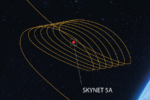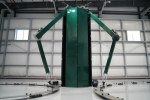Northrop Grumman has initiated flight trials of its experimental “Beacon” uncrewed aircraft system (UAS), a key step in the U.S. Air Force’s push toward integrating artificial intelligence (AI) into manned-unmanned teaming (MUM-T) concepts. The program serves as a testbed for future Collaborative Combat Aircraft (CCA), part of the Next Generation Air Dominance (NGAD) family of systems.
Beacon Drone: A Testbed for Manned-Unmanned Teaming
The Beacon UAS is Northrop Grumman’s entrant into the U.S. Air Force Research Laboratory’s (AFRL) Autonomous Collaborative Platforms program. Designed as a low-cost, attritable platform with modular architecture, Beacon is intended to validate autonomy software stacks and mission-level behaviors that will later be integrated into operational CCAs.
According to AFRL and Northrop Grumman statements released in mid-2024, the drone is not meant for direct deployment but rather serves as a surrogate platform for rapid iteration and risk reduction. The platform supports open mission systems and modular payloads to allow integration of third-party autonomy algorithms and sensors.
Beacon’s design draws from lessons learned during earlier programs such as Skyborg and DARPA’s ACE (Air Combat Evolution), both of which emphasized real-time decision-making by AI agents in dynamic air combat environments. The aircraft will be used extensively to test human-machine interface protocols, autonomous flight control logic, sensor fusion pipelines, and distributed mission planning tools.
Flight Testing Objectives and Timeline
The first phase of flight trials began at an undisclosed test range in late August 2025. Initial sorties are focused on validating basic airworthiness parameters—flight stability, command latency over datalinks, and safety-of-flight logic under autonomous control modes.
Later phases will introduce more complex scenarios including:
- Multi-aircraft coordination with other uncrewed platforms
- Simulated suppression of enemy air defenses (SEAD)
- Dynamic retasking based on sensor inputs
- Autonomous threat prioritization and engagement recommendations
The AFRL aims to complete core testing by mid-2026 before transitioning validated autonomy packages into prototype CCAs under development by Boeing, Lockheed Martin-Skunk Works, Anduril Industries, and Northrop Grumman itself.
Role Within the CCA Ecosystem
The Beacon drone supports broader USAF efforts under the CCA initiative—a central component of NGAD—which envisions manned fighters like the sixth-generation NGAD platform operating alongside multiple autonomous or semi-autonomous wingmen. These CCAs would carry sensors or weapons depending on mission needs while being optionally expendable depending on cost thresholds.
The USAF plans to procure at least 1,000 CCAs in two capability increments starting from FY2028. Increment 1 focuses on basic teaming with F-22/F-35-class fighters; Increment 2 introduces more advanced capabilities tailored for NGAD integration. While Beacon itself is not a production candidate for either increment, it plays a critical role in shaping software architectures and operational concepts that will inform those future platforms.
AI Autonomy Stack Development
A key focus area for Beacon is validating AI-driven autonomy stacks capable of operating with limited or no datalink connectivity—critical in contested environments where communications may be jammed or degraded. Northrop Grumman has partnered with several software firms under AFRL contracts to integrate machine learning-based perception modules trained on synthetic data sets generated via digital twins and LVC (Live-Virtual-Constructive) simulations.
This includes reinforcement learning agents trained through millions of simulated combat encounters using high-fidelity physics engines like AFSIM (Advanced Framework for Simulation Integration). These agents are then ported onto onboard processors within the Beacon airframe for real-world validation against live threats or surrogate adversaries like QF-16 drones.
Industrial Implications and Competitive Landscape
The launch of Beacon trials positions Northrop Grumman competitively within the emerging CCA market space. Boeing has already flown its MQ-28 Ghost Bat demonstrator developed with Australia; Lockheed Martin continues internal work on its own CCA prototypes; Anduril recently unveiled its Fury-class UAS optimized for distributed operations.
What distinguishes Northrop’s approach is its focus on software-first development cycles enabled by digital engineering pipelines—allowing rapid updates via DevSecOps frameworks without requiring major hardware redesigns. This aligns with AFRL’s goal of fielding adaptable systems that can evolve faster than traditional acquisition timelines allow.
Conclusion: Shaping Future Airpower Through Iterative Autonomy Testing
While not destined for frontline service itself, the Beacon drone represents a critical stepping stone toward realizing fully integrated manned-unmanned combat teams. Its role as an autonomy test surrogate allows developers to iterate faster while reducing risk ahead of large-scale procurement decisions tied to NGAD timelines.
If successful, insights from Beacon could shape how future USAF pilots interact with machine teammates—delegating tasks dynamically based on mission context while maintaining human-on-the-loop oversight where needed. As great-power competition intensifies across Indo-Pacific theaters where air superiority remains contested, such capabilities may prove decisive.









